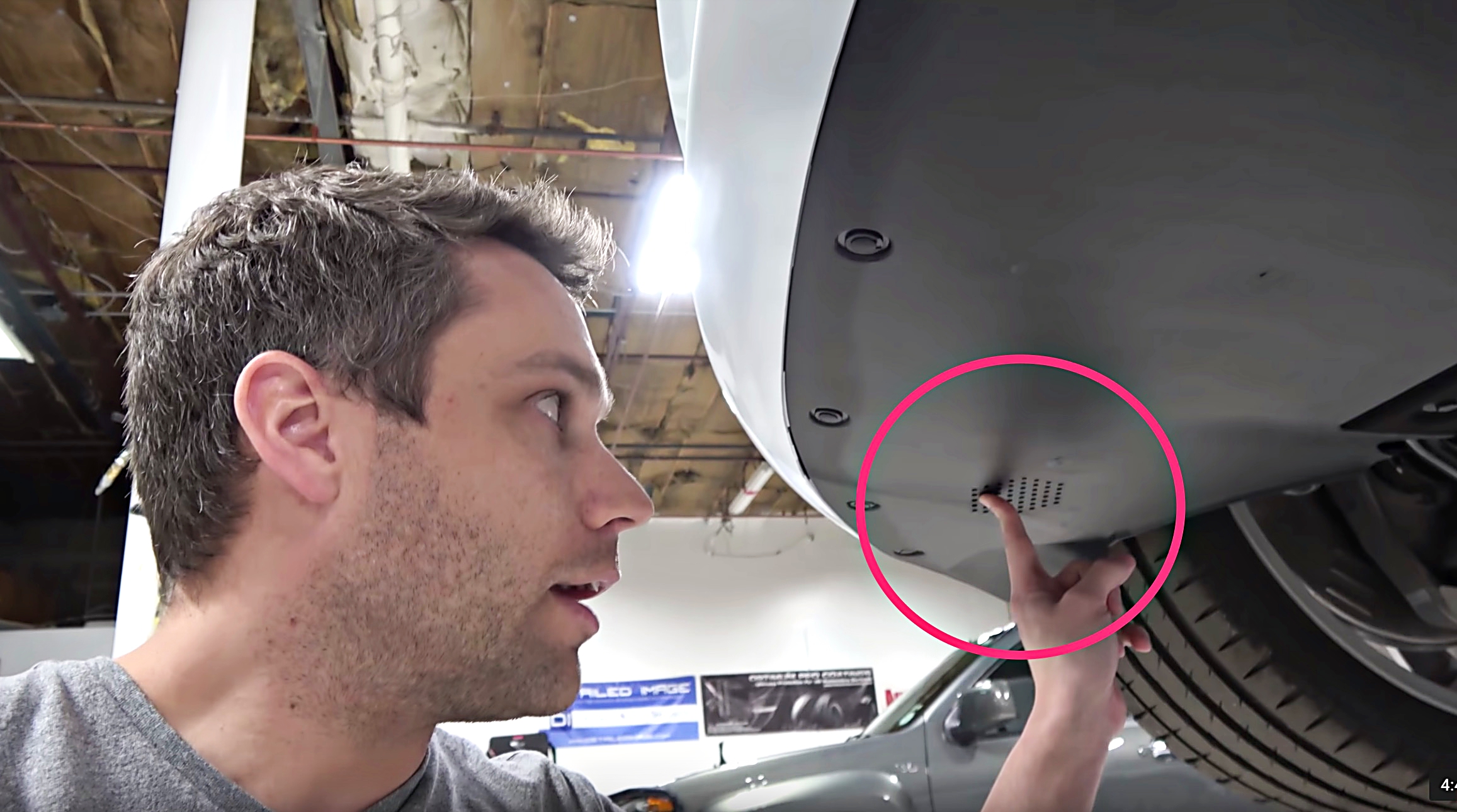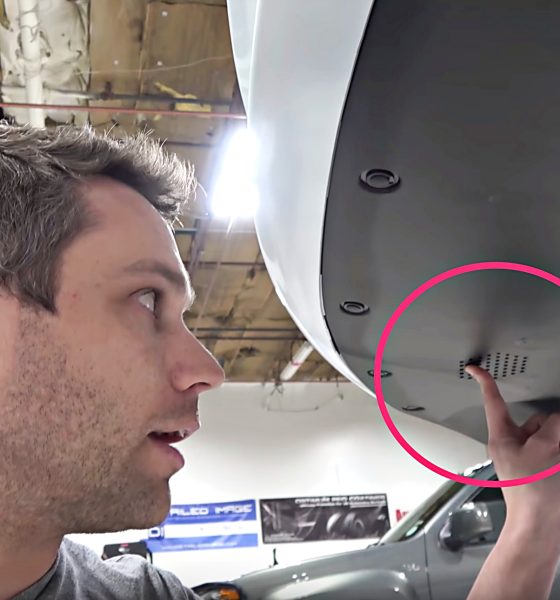

News
Tesla Model 3 spotted with “pedestrian noise maker” ahead of NHTSA mandate
It looks like Tesla may have already begun getting its newer manufactured vehicles ready for compliance with an upcoming National Highway Traffic Safety Administration (NHTSA) requirement for electric and hybrid electric vehicles to make noise when traveling at slow speeds. In a video posted by Tesla community’s resident DIY expert, Erik, or otherwise known as DÆrik from his YouTube channel, the undercarriage panel of his Performance Model 3 has what appears to be a speaker grill – the front paneling is adorned with a series of holes in a hexagonal shape. Once the paneling is removed, three mounting points are revealed to be molded into the same area, hinting at a future device to come.
The video was made in response to inquiries about a photo of the Tesla’s undercarriage posted to Erik’s Instagram account where someone noted the series of holes in the plastic panel below the front bumper. Tesla’s parts catalog doesn’t currently show the grill cutout, but As Erik notes in the video, he found a Model S diagram three years ago showing a layout including a future noise maker labeled “Speaker Pedestrian Noise”.
We’ve reached out to Tesla for comment about the new “speaker grill” found in the underside of the Model 3 and will provide updates as we receive them.
https://www.instagram.com/p/BsYwz0ygTB5/
Blind pedestrians rely heavily on auditory clues to anticipate traffic patterns and know a vehicle is near, and that means the quiet nature of electric and hybrid vehicles at low speeds may pose a greater danger to them than traditional internal combustion engine (ICE) vehicles. Bicyclists and other pedestrians also utilize usual car sounds as part of their personal safety awareness, so there’s a population of travelers that could be significantly impacted by the influx of EV/HEV vehicles on the roads. The potential danger has not gone unnoticed by those in charge of public safety.
This concern was elevated to the federal level by the NHTSA, and the eventual result was a 2010 law (Pedestrian Safety Enhancement Act of 2010) requiring electric and hybrid vehicle manufacturers to install devices which emit noise while traveling slower than about 19 mph. Higher speeds have tire and wind noise that’s sufficient for pedestrian needs. The implementation rules were finalized in February last year, and manufacturers have until September 1, 2020, to be fully compliant, with half of the vehicles equipped by September 1, 2019.
While the proposal may not be popular with all parties involved, the NHTSA points to its October 2009 report entitled “Research on Quieter Cars and the Safety of Blind Pedestrians, a Report to Congress” as a primary basis for its rulemaking. In the report, the agency found an increased rate of accidents involving pedestrians with hybrid-electric vehicles compared to ICE vehicles in roadways and zones with low-speed limits, during the type of weather or any time of day. By implementing the rules as passed, the NHTSA expects to prevent 2,400 injuries and reduce the $250-$320 million costs which result annually due to limited ability to detect quiet EVs/HEVs.
POPULAR: DIY Tesla Model S Pedestrian Alert: “Horn” for the Oblivious
Another coming requirement is that the noise emitted must be identifiable as a vehicle, a limitation that will likely only inspire creativity. If manufacturers want to take a fun route with the noise options, i.e, license the Jetson family’s flying car sound from Hanna Barbara as suggested by Erik, they’ll have to make sure it’s consistent among their vehicles – or at least consistent among package options. Also, drivers cannot be allowed to modify the sound themselves.
Manufacturers are free to modify the sounds from the factory end, though, an option Tesla’s CEO Elon Musk has previously capitalized on for other noise-centric features in the electric car company’s vehicles. However, letting drivers determine their car’s noise via app or button push is still in the air. The NHTSA will publish a separate document at a later date to determine whether driver-selectable sounds are a good idea, or at least compliant with the purpose of the law.
Watch the video below to see Erik’s Model 3 inspection:

News
Tesla aims to combat common Full Self-Driving problem with new patent
Tesla writes in the patent that its autonomous and semi-autonomous vehicles are heavily reliant on camera systems to navigate and interact with their environment.

Tesla is aiming to combat a common Full Self-Driving problem with a new patent.
One issue with Tesla’s vision-based approach is that sunlight glare can become a troublesome element of everyday travel. Full Self-Driving is certainly an amazing technology, but there are still things Tesla is aiming to figure out with its development.
Unfortunately, it is extremely difficult to get around this issue, and even humans need ways to combat it when they’re driving, as we commonly use sunglasses or sun visors to give us better visibility.
Cameras obviously do not have these ways to fight sunglare, but a new patent Tesla recently had published aims to fight this through a “glare shield.”
Tesla writes in the patent that its autonomous and semi-autonomous vehicles are heavily reliant on camera systems to navigate and interact with their environment.

The ability to see surroundings is crucial for accurate performance, and glare is one element of interference that has yet to be confronted.
Tesla described the patent, which will utilize “a textured surface composed of an array of micro-cones, or cone-shaped formations, which serve to scatter incident light in various directions, thereby reducing glare and improving camera vision.”

The patent was first spotted by Not a Tesla App.
The design of the micro-cones is the first element of the puzzle to fight the excess glare. The patent says they are “optimized in size, angle, and orientation to minimize Total Hemispherical Reflectance (THR) and reflection penalty, enhancing the camera’s ability to accurately interpret visual data.”
Additionally, there is an electromechanical system for dynamic orientation adjustment, which will allow the micro-cones to move based on the angle of external light sources.
This is not the only thing Tesla is mulling to resolve issues with sunlight glare, as it has also worked on two other ways to combat the problem. One thing the company has discussed is a direct photon count.
CEO Elon Musk said during the Q2 Earnings Call:
“We use an approach which is direct photon count. When you see a processed image, so the image that goes from the sort of photon counter — the silicon photon counter — that then goes through a digital signal processor or image signal processor, that’s normally what happens. And then the image that you see looks all washed out, because if you point the camera at the sun, the post-processing of the photon counting washes things out.”
Future Hardware iterations, like Hardware 5 and Hardware 6, could also integrate better solutions for the sunglare issue, such as neutral density filters or heated lenses, aiming to solve glare more effectively.
Elon Musk
Delaware Supreme Court reinstates Elon Musk’s 2018 Tesla CEO pay package
The unanimous decision criticized the prior total rescission as “improper and inequitable,” arguing that it left Musk uncompensated for six years of transformative leadership at Tesla.

The Delaware Supreme Court has overturned a lower court ruling, reinstating Elon Musk’s 2018 compensation package originally valued at $56 billion but now worth approximately $139 billion due to Tesla’s soaring stock price.
The unanimous decision criticized the prior total rescission as “improper and inequitable,” arguing that it left Musk uncompensated for six years of transformative leadership at Tesla. Musk quickly celebrated the outcome on X, stating that he felt “vindicated.” He also shared his gratitude to TSLA shareholders.
Delaware Supreme Court makes a decision
In a 49-page ruling Friday, the Delaware Supreme Court reversed Chancellor Kathaleen McCormick’s 2024 decision that voided the 2018 package over alleged board conflicts and inadequate shareholder disclosures. The high court acknowledged varying views on liability but agreed rescission was excessive, stating it “leaves Musk uncompensated for his time and efforts over a period of six years.”
The 2018 plan granted Musk options on about 304 million shares upon hitting aggressive milestones, all of which were achieved ahead of time. Shareholders overwhelmingly approved it initially in 2018 and ratified it once again in 2024 after the Delaware lower court struck it down. The case against Musk’s 2018 pay package was filed by plaintiff Richard Tornetta, who held just nine shares when the compensation plan was approved.
A hard-fought victory
As noted in a Reuters report, Tesla’s win avoids a potential $26 billion earnings hit from replacing the award at current prices. Tesla, now Texas-incorporated, had hedged with interim plans, including a November 2025 shareholder-approved package potentially worth $878 billion tied to Robotaxi and Optimus goals and other extremely aggressive operational milestones.
The saga surrounding Elon Musk’s 2018 pay package ultimately damaged Delaware’s corporate appeal, prompting a number of high-profile firms, such as Dropbox, Roblox, Trade Desk, and Coinbase, to follow Tesla’s exodus out of the state. What added more fuel to the issue was the fact that Tornetta’s legal team, following the lower court’s 2024 decision, demanded a fee request of more than $5.1 billion worth of TSLA stock, which was equal to an hourly rate of over $200,000.
Delaware Supreme Court Elon Musk 2018 Pay Package by Simon Alvarez
News
Tesla Cybercab tests are going on overdrive with production-ready units
Tesla is ramping its real-world tests of the Cybercab, with multiple sightings of the vehicle being reported across social media this week.

Tesla is ramping its real-world tests of the Cybercab, with multiple sightings of the autonomous two-seater being reported across social media this week. Based on videos of the vehicle that have been shared online, it appears that Cybercab tests are underway across multiple states.
Recent Cybercab sightings
Reports of Cybercab tests have ramped this week, with a vehicle that looked like a production-ready prototype being spotted at Apple’s Visitor Center in California. The vehicle in this sighting was interesting as it was equipped with a steering wheel. The vehicle also featured some changes to the design of its brake lights.
The Cybercab was also filmed testing at the Fremont factory’s test track, which also seemed to involve a vehicle that looked production-ready. This also seemed to be the case for a Cybercab that was spotted in Austin, Texas, which happened to be undergoing real-world tests. Overall, these sightings suggest that Cybercab testing is fully underway, and the vehicle is really moving towards production.
Production design all but finalized?
Recently, a near-production-ready Cybercab was showcased at Tesla’s Santana Row showroom in San Jose. The vehicle was equipped with frameless windows, dual windshield wipers, powered butterfly door struts, an extended front splitter, an updated lightbar, new wheel covers, and a license plate bracket. Interior updates include redesigned dash/door panels, refined seats with center cupholders, updated carpet, and what appeared to be improved legroom.
There seems to be a pretty good chance that the Cybercab’s design has been all but finalized, at least considering Elon Musk’s comments at the 2025 Annual Shareholder Meeting. During the event, Musk confirmed that the vehicle will enter production around April 2026, and its production targets will be quite ambitious.








